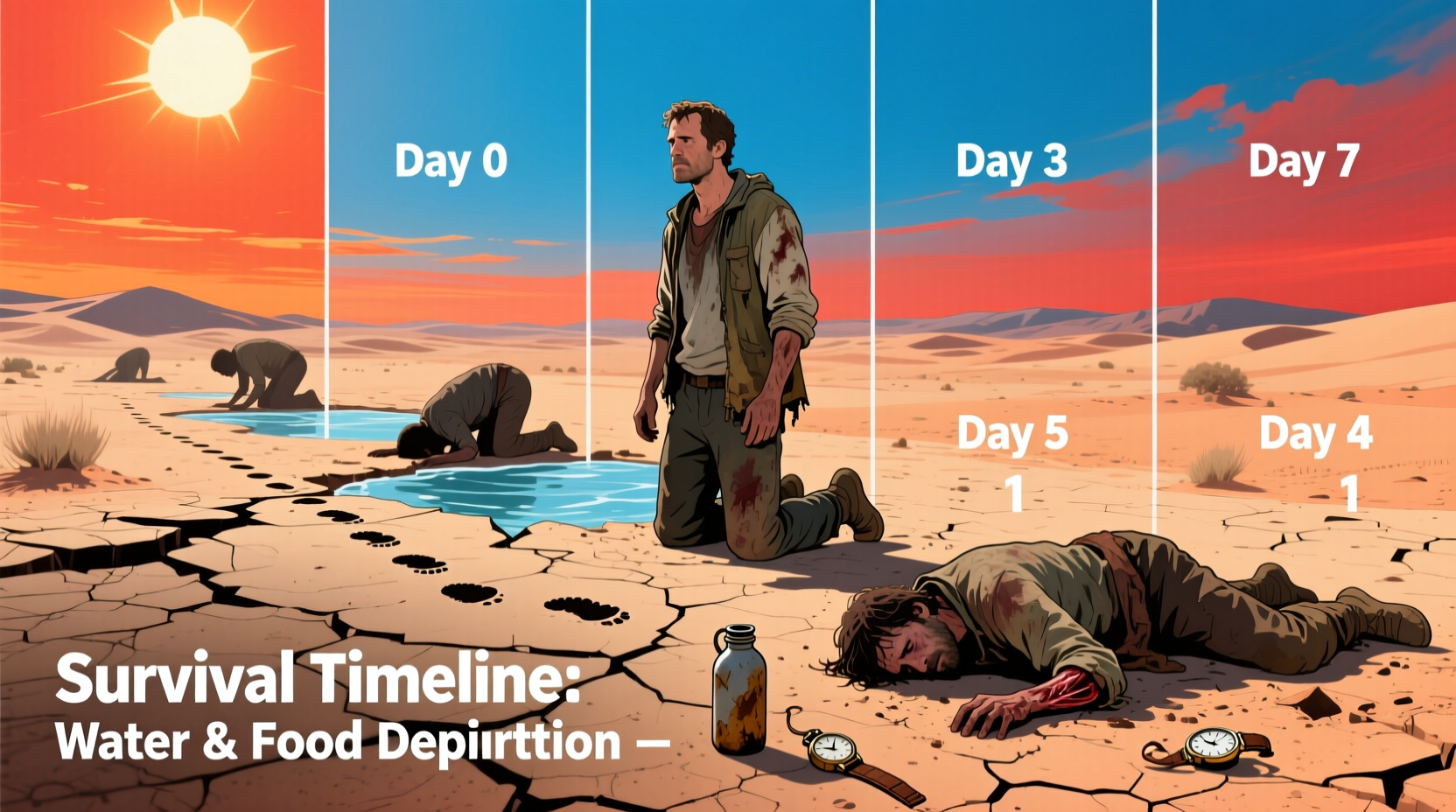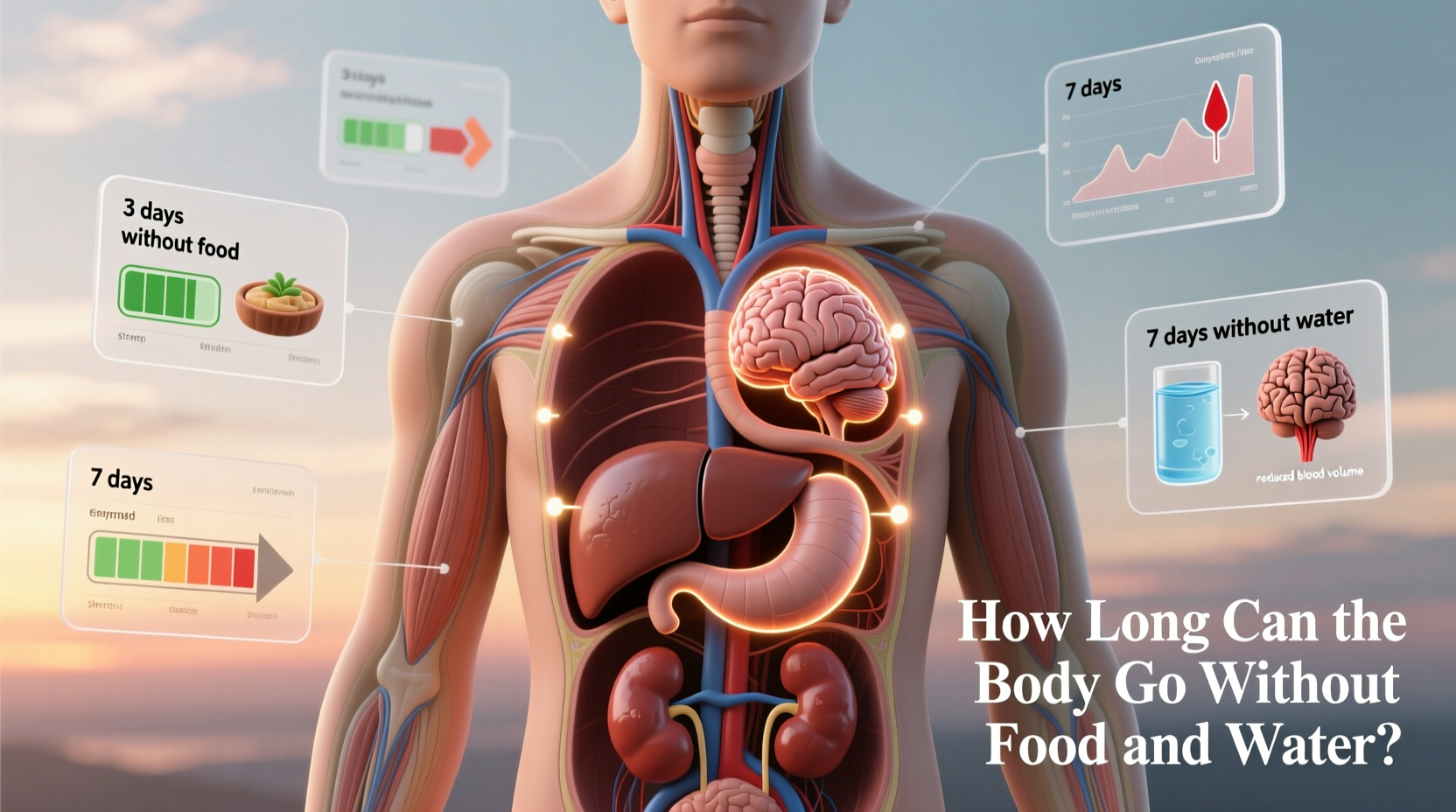The human body can typically survive 3-4 days without water and approximately 3 weeks without food, though these timelines vary significantly based on individual health, environmental conditions, and other critical factors. Extreme temperatures, physical exertion, and pre-existing medical conditions can dramatically shorten these survival windows.
Understanding human survival limits isn't just theoretical knowledge—it's potentially life-saving information for hikers, emergency responders, and anyone preparing for unexpected situations. This guide delivers medically accurate timelines backed by clinical research, helping you recognize critical warning signs and make informed decisions when resources become scarce.
Water Deprivation: The Critical Timeline
Water represents approximately 60% of adult body weight and is essential for nearly every bodily function. Without adequate hydration, physiological deterioration begins within hours. According to the Centers for Disease Control and Prevention, dehydration becomes dangerous much faster than most people realize.
| Time Without Water | Physiological Changes | Observable Symptoms |
|---|---|---|
| 12-24 hours | Reduced urine output, increased heart rate | Thirst, dry mouth, fatigue |
| 24-48 hours | Significant electrolyte imbalance, reduced kidney function | Dark urine, dizziness, headache |
| 48-72 hours | Organ stress, impaired cognitive function | Confusion, rapid heartbeat, minimal urine |
| 72+ hours | Critical organ failure risk | Delirium, loss of consciousness, coma |
This timeline illustrates why water deprivation becomes life-threatening so rapidly. The Mayo Clinic emphasizes that individual survival duration varies based on climate conditions—extreme heat can reduce survival time to under 24 hours, while cooler environments might extend it to 7 days for healthy adults.

Food Deprivation: Understanding the Body's Adaptation Process
Unlike water, the body has evolved mechanisms to endure extended periods without food. The American Medical Association notes that survival without food typically spans 3 weeks but can extend to 2 months under optimal conditions. This extended timeline occurs through carefully orchestrated physiological adaptations:
- Glycogen depletion (24-48 hours): The body exhausts stored carbohydrates
- Ketosis begins (3-5 days): Fat stores become the primary energy source
- Protein conservation (1-2 weeks): The body minimizes muscle breakdown
- Metabolic slowdown (3+ weeks): Basal metabolic rate decreases by up to 40%
Research published in the American Journal of Clinical Nutrition demonstrates that body fat percentage significantly impacts survival duration. Individuals with higher adipose tissue reserves may survive 25-40% longer than those with minimal body fat, assuming identical environmental conditions.
Key Variables That Dramatically Alter Survival Timelines
Several critical factors can shorten or extend survival time beyond general estimates. Understanding these context boundaries helps assess real-world scenarios more accurately:
- Environmental temperature: Extreme heat increases water needs by 50-100% according to CDC guidelines
- Physical exertion: Moderate activity doubles fluid requirements
- Health status: Diabetes, kidney disease, or fever drastically reduce survival windows
- Age factors: Children and elderly face accelerated dehydration risks
- Acclimatization: People adapted to arid environments may survive 20-30% longer
The National Institutes of Health emphasizes that individual variation makes precise predictions impossible. A healthy 25-year-old in cool conditions might survive 5 days without water, while an elderly person with diabetes in desert heat could succumb within 24 hours.
Recognizing Critical Warning Signs
Knowing when to seek immediate medical attention could mean the difference between recovery and permanent damage. The American College of Emergency Physicians identifies these critical indicators:
Severe Dehydration Red Flags
- No urine output for 12+ hours
- Sunken eyes and extreme dryness of mucous membranes
- Inability to keep fluids down
- Systolic blood pressure below 90 mmHg
Advanced Starvation Indicators
- Edema (swelling) in extremities
- Abnormal heart rhythms
- Severe muscle wasting affecting breathing
- Body temperature below 95°F (35°C)
These symptoms indicate medical emergencies requiring immediate professional intervention. The American College of Emergency Physicians stresses that attempting to rapidly rehydrate severely dehydrated individuals can cause dangerous electrolyte imbalances.
Practical Preparedness Strategies
While understanding survival limits is valuable, prevention remains the most effective strategy. Emergency medical professionals recommend these evidence-based approaches:
- Maintain a 3-day emergency water supply (1 gallon per person daily)
- Include electrolyte replacement solutions in emergency kits
- Learn to recognize early dehydration signs before severe symptoms develop
- Understand that urine color provides immediate hydration status feedback
- Carry high-calorie, nutrient-dense emergency food requiring no preparation
Remember that survival timelines represent absolute limits—not targets to approach. The American Red Cross emphasizes that cognitive impairment begins long before critical survival thresholds, compromising decision-making abilities when they're most needed.
How long can a healthy adult survive without water in desert conditions?
In extreme desert conditions (temperatures above 100°F/38°C), survival without water typically ranges from 12 to 24 hours. The combination of high heat and physical exertion accelerates fluid loss, with the body potentially losing 1-2 liters of fluid per hour through sweat alone.
Can drinking small amounts of water extend survival time significantly?
Yes, consuming even small amounts of water (4-8 ounces every hour) can extend survival time by 50-100% compared to complete water deprivation. Research shows that maintaining minimal hydration slows the progression of organ stress and preserves cognitive function longer.
What happens to the body during the first week without food?
During the first week without food, the body transitions through distinct metabolic phases: glycogen stores deplete within 24-48 hours, then ketosis begins as fat stores become the primary energy source. By day 5-7, protein breakdown increases as the body starts using muscle tissue for energy, though metabolic rate slows to conserve resources.
Does body weight affect survival duration without food?
Yes, body composition significantly impacts survival time. Individuals with higher body fat percentages generally survive longer without food, as adipose tissue provides substantial energy reserves. However, extremely obese individuals may face additional complications from pre-existing health conditions that could shorten survival time despite greater fat stores.
When should medical help be sought for suspected dehydration?
Seek immediate medical attention if experiencing no urine output for 12+ hours, confusion or disorientation, rapid heartbeat (over 100 bpm), or inability to keep fluids down. These indicate severe dehydration requiring professional treatment, as attempting rapid rehydration at home could cause dangerous electrolyte imbalances.











 浙公网安备
33010002000092号
浙公网安备
33010002000092号 浙B2-20120091-4
浙B2-20120091-4